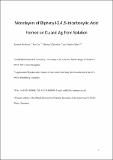Files in this item
Monolayers of biphenyl-3,4',5-tricarboxylic acid formed on Cu and Ag from solution
Item metadata
| dc.contributor.author | Aitchison, Hannah | |
| dc.contributor.author | Lu, Hao | |
| dc.contributor.author | Zharnikov , Michael | |
| dc.contributor.author | Buck, Manfred | |
| dc.date.accessioned | 2016-05-21T23:32:22Z | |
| dc.date.available | 2016-05-21T23:32:22Z | |
| dc.date.issued | 2015-06-25 | |
| dc.identifier | 188758870 | |
| dc.identifier | 3eb6c7bc-3e28-46af-b5e7-1a8c93e5fe54 | |
| dc.identifier | 84933055000 | |
| dc.identifier | 000357140500015 | |
| dc.identifier.citation | Aitchison , H , Lu , H , Zharnikov , M & Buck , M 2015 , ' Monolayers of biphenyl-3,4',5-tricarboxylic acid formed on Cu and Ag from solution ' , Journal of Physical Chemistry C , vol. 119 , no. 25 , pp. 14114–14125 . https://doi.org/10.1021/acs.jpcc.5b01176 | en |
| dc.identifier.issn | 1932-7447 | |
| dc.identifier.other | ORCID: /0000-0003-1225-7607/work/56861193 | |
| dc.identifier.uri | https://hdl.handle.net/10023/8850 | |
| dc.description | Support by The Leverhulme Trust and an EPSRC doctoral training grant is gratefully acknowledged. This work was supported by funding from the European Community’s Seventh Framework Programme (FP7/2007-2013) CALIPSO under grant agreement n° 312284. | en |
| dc.description.abstract | Self-assembled monolayers of biphenyl-3,4’,5-tricarboxylic acid (BPTCA) on Au(111)/mica substrates modified by under-potential deposited layers of Cu and Ag were studied by scanning tunneling microscopy under ambient conditions as well as by synchrotron based X-ray photoelectron spectroscopy and near-edge X-ray absorption fine structure spectroscopy. BPTCA forms distinctly different layers on Ag and Cu due to a pronounced influence of the substrate on the balance of intermolecular and molecule-substrate interactions. On Cu a highly crystalline commensurate row structure is formed, described by a 6×√3 unit cell, a molecular tilt of 45-50° relative to the surface normal, and a bipodal bidentate adsorption geometry. In contrast, incommensurate row structures are formed on Ag which are characterized by significant waves and kinks, a monopodal bidentate adsorption geometry, and a tilt angle of 25-30°. While BPTCA parallels its smaller homologue, benzene-1,3,5-tricarboxylic acid, with regard to the substrate specific monopodal and bipodal adsorption geometries, the preparation conditions for the monolayer on Cu and the film structure on Ag are pronouncedly different. The results are discussed in terms of the steric requirements and molecular symmetry of BPTCA. | |
| dc.format.extent | 816175 | |
| dc.language.iso | eng | |
| dc.relation.ispartof | Journal of Physical Chemistry C | en |
| dc.subject | QD Chemistry | en |
| dc.subject | NDAS | en |
| dc.subject | BDC | en |
| dc.subject.lcc | QD | en |
| dc.title | Monolayers of biphenyl-3,4',5-tricarboxylic acid formed on Cu and Ag from solution | en |
| dc.type | Journal article | en |
| dc.contributor.sponsor | The Leverhulme Trust | en |
| dc.contributor.institution | University of St Andrews. EaSTCHEM | en |
| dc.contributor.institution | University of St Andrews. School of Chemistry | en |
| dc.identifier.doi | 10.1021/acs.jpcc.5b01176 | |
| dc.description.status | Peer reviewed | en |
| dc.date.embargoedUntil | 2016-05-22 | |
| dc.identifier.grantnumber | RPG-2013-177 | en |
This item appears in the following Collection(s)
Items in the St Andrews Research Repository are protected by copyright, with all rights reserved, unless otherwise indicated.

